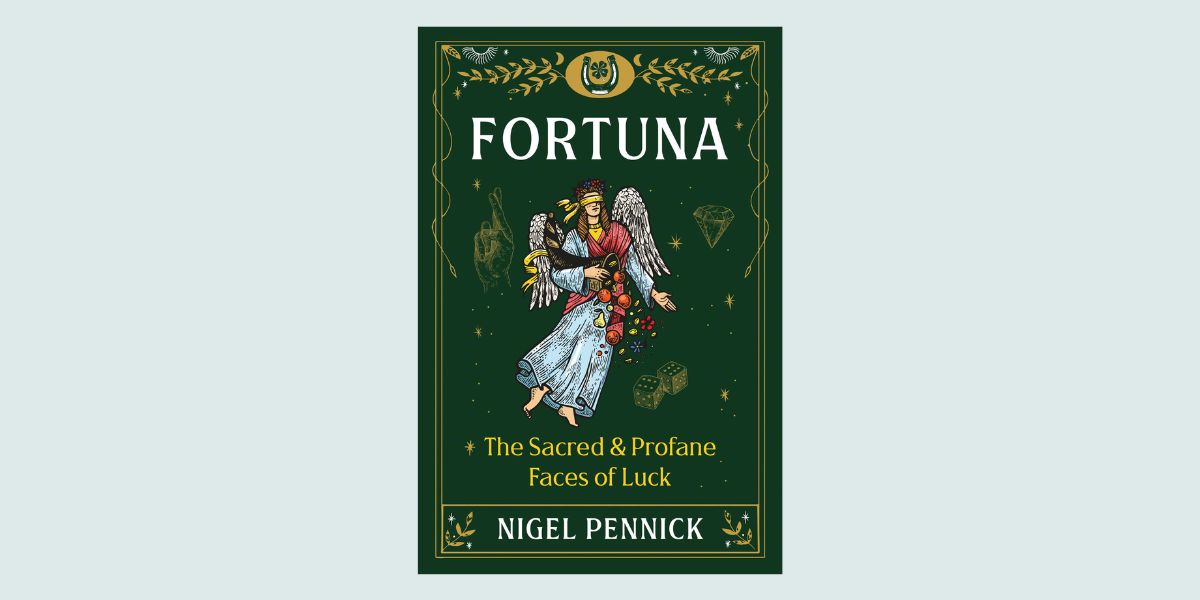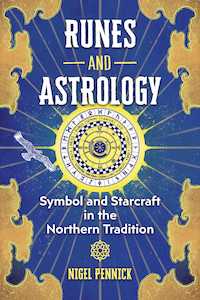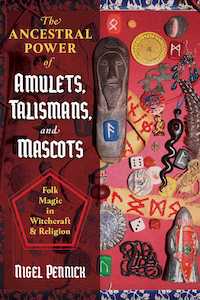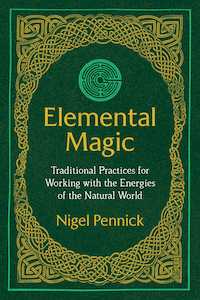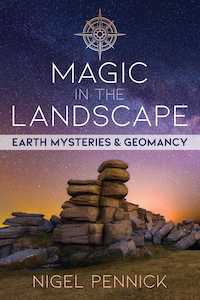
Fortuna: The Sacred & Profane Faces of Luck, by Nigel Pennick
Destiny Books, 1644116472, 144 pages, January 2024
Luck is a mysterious and capricious supernatural force thought to bring about success or failure by apparently random chance. While belief in luck may be relegated to gamblers and the superstitious, the concept is deeply embedded in Western culture. Luck was personified by the ancient Greeks as Tyche, and the ancient Romans knew her as Fortuna, the fickle and fearsome goddess of fortune and fate. “O Fortuna,” a Latin poem derived from the medieval manuscript Carmina Burana, which laments the vicissitudes of fate, was set to music by German composer Carl Orff in 1936, and the epic cantata has since appeared in several films, television shows, and commercials. Fortuna’s Wheel of Fortune appears in both the tarot and the syndicated game show of the same name, which holds the record as the longest-running game show in the United States.1
While Fortuna’s indiscriminate giving and taking is often perceived as mercurial and even cruel, her lighter and brighter side is known today as Lady Luck, and she is still alive and well in contemporary culture, from the four leaf clover marshmallows in Lucky Charms cereal to Felix Felicis, the alchemical Liquid Luck elixir Harry Potter downed in J.K. Rowling’s Harry Potter and the Half-Blood Prince. Luck can simply mean being in the right place at the right time. But beyond the superficial veneer of pop culture, who is she, really?
In Fortuna: The Sacred & Profane Faces of Luck, Nigel Pennick, the prolific author of over sixty books, including Elemental Magic (2020), Magic in the Landscape (2020), The Ancestral Power of Amulets, Talismans, and Mascots (2021), and Runes and Astrology (2023), explores the origins and evolution of the concept of luck, from divination to gambling. This slim volume is a quick read, with just a little over a hundred pages, but it is packed with fascinating insights.
Contemporary consciousness tends to rationalize changes in fortune as nothing more than random occurrences, but, as Pennick says in the Introduction, “in the ancient worldview nothing happens by chance but is the manifestation of an act of divine will.”2 Feeling subject to the whims of the gods, ancient people sought to discern the divine will by interpreting signs and omens, which led to the rise of divination with various systems, involving objects with numeric values, such as dice and cowrie shells.
In the absence of the concept of mathematical probability, everything was believed to have been preordained by the divine. The belief in predestination was ripe for abuse, as it could be used to validate the unjust actions of people in positions of authority. “Many religions view the Creator in the form of an angry Bronze Age law-making warlord who decides how the natural world must behave and who issues the laws that define those behaviors,”3 Pennick says. The real power behind the scenes, however, was the goddess of fortune and fate.
In Chapter 2, titled “Lady Luck and the Goddess Fortuna,” Pennick explores the history of the Roman goddess Fortuna’s worship. Today, we tend to simplify her as the personification of luck, chance, and good fortune, but Pennick does her honor by fleshing her out as a complex goddess associated with many facets of life. She had a plethora of epithets, such as Fortuna Plebis, “of the People,”4 for she determined the fates of individuals. Many epithets include types of people and social classes, such as Fortuna Muliebris (“Women”), Fortuna Patricia (“Noble”), and Fortuna Equestris (“Horseback Riding”), which brings to mind knights in shining armor astride dashing steeds. The one that struck me as the most interesting was Fortuna Aucupium, meaning “Bird of Prey.”5 Although she was sometimes depicted as blind, this avian title seems to imply keen powers of perception and a shrewd eye for swooping down and snatching good fortune at a crucial moment.
“In Rome, the emperor Trajan (98-117 CE) dedicated a major temple to each aspect of the goddess, and on every January 1, offerings were made at the temples to ensure good luck and success for the coming year,”6 Pennick says. Fortuna’s accoutrements included a cornucopia, or horn of plenty, aligning her with the goddess Abundantia, the Roman goddess of prosperity; a ship’s rudder, which signifies her steering the fates of all mortals; and the vertically spinning wheel of fortune. On occasion, Fortuna appeared with wings, like Nortia, the Etruscan goddess of fate.
There were oracular shrines devoted to Fortuna in ancient Rome, which were located at Antium and Praeneste, in the modern day city of Palestrina. I was most intrigued by the Praenestine oracle of Fortuna, which is believed to have operated underground in a cave called “Antro delle Sorti” in Italian, which means “the Cavern of the Fates.”7 The oracle was thought to have been founded by an Egyptian priestess of the goddess Isis, and incorporated the use of wooden dice inscribed with letters, which may have been derived from Etruscan divinatory practices, and Pennick believes this oracle might have influenced the development of runic divination.
“The cubes were thrown into a silver bowl and drawn out one by one to produce a sequence of letters that were taken as the first letters of words,” Pennick says. “Interpretative skill depended upon determining what the sequence of letters stood for with regard to the question asked or the person asking it.”8 The Praenestine oracle had a revival in nineteenth century France, “when it was claimed that Charles Le Clerc used the oracle to attain prophecies for Napoleon Bonaparte.”9
Pennick then explores the history of dice as a form of divination in ancient Europe, which were originally made from the knuckle bones of sheep. He writes about the practice of gambling in ancient Rome and presents a table depicting the names and measurements of Roman dice. Chapter 4 is devoted to dice divination, complete with a chart of the divinatory meanings of possible throws.
One of my favorite chapters is on “Divinatory Geomancy,” in which Pennick gives a concise explanation of how to perform a geomantic reading and presents different methods for generating geomantic figures. Geomancy, which means “earth divination,” is a binary method of generating four-lined figures using odd or even numbers that traditionally involves making marks in the earth, although modern practitioners of the art may choose to throw dice or coins. There are a total of sixteen possible geomantic figures, and each has a Latin name with an oracular meaning and an astrological association.10
“An East Anglian technique for generating odd and even sequences uses potatoes,”11 Pennick writes. Using root vegetables sounds like the perfect way to perform an earth divination! I personally use a simple homemade deck of geomancy cards I created with blank index cards, on which I drew the geomantic figures with markers, but I love the idea of using potatoes to generate geometric figures.
“Each potato is different, for each has an indeterminate number of eyes, the places from which new growth takes place,” Pennick says. “To generate a geomantic figure, one must take four potatoes at random and count the eyes on each one.”12 A full reading requires sixteen spuds, so this might be a fun method to try if you have a sack of potatoes handy.
The latter half of the book explores how the sacred art of divination devolved into the profane practice of gambling and became associated with the Devil. “Perhaps the ancient Jewish prohibition of divination, which was taken up wholesale and unthinkingly into the Christian religion when Christianity split off from Judaism, accelerated the desacralization of divination into gambling,”13 Pennick says. He believes that “the association of cards with the Devil is likely to be a cultural leftover from the centuries of religious fulmination against games and the religiously motivated laws that prohibited all forms of play and gambling for so many centuries.”14
I was fascinated to learn that, in medieval England, “Christmas was deemed to be the only time that games were allowed, and playing at other times was forbidden by law.”15 Hearkening back to the ancient Roman festival of Saturnalia, “the connection of gambling with misrule is overt in writings about carnivals and mythical lands, such as the Land of Cokaygne.”16
Pennick also reveals how fortune-telling and luck-drawing magic have intersected with gambling superstitions and dice cheat rolls. “Ancient crooked dice” might have been used for gambling cheats, “but they may well have been used at oracular shrines to skew the readings of those who came to ask questions.”17 This may have been a matter of self-preservation, especially when the interpreters of omens “had to deal with ruthless tyrants and a wrong answer might mean torture and death.”18
The stakes are high in illegal gambling as well, and the sacred caves where the ancients once consulted Fortuna for spiritual guidance were traded in for the Underworld gambling dens of organized crime, which were crowded with the lost souls suffering from addiction to these illicit practices. Since such risky behavior is a flirtation with death, it’s no wonder that many gambling charms incorporate images of human skulls to represent luck in the face of adversity.
“When we dice with Death, we can be sure that Death has the dice in a special grip and throws all the shots, and the dice are probably loaded,”19 Pennick writes.
Pennick’s impeccable scholarship and concise historical survey of divination and gambling has transformed my perspective of Lady Fortuna and the relationship between her sacred and profane arts. Whether you are a practitioner of divination and magic or a gambler hoping to boost your luck, Fortuna: The Sacred & Profane Faces of Luck will inspire your practice and be a boon to your personal library. Besides, with St. Patrick’s Day being just around the corner, it’s a great read for the month of March. May the luck of the Irish be with you!

Rachel Christina McConnell is a witch, tarot reader, intuitive astrologer, and writing spider. She holds an MFA in Fiction from Columbia University in the City of New York. Her short stories have appeared in Dark Moon Lilith Press and Minerva Rising Press’s The Keeping Room. Links to her publications are available here: https://rachelchristinamcconnell.wordpress.com
